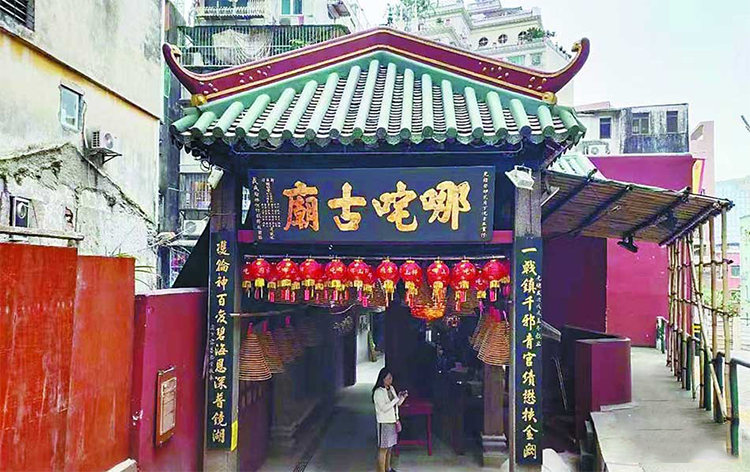Macau Nezha Temple: Shishan’s Historic Folk Shrine & Visitor Guide
Shishan Nezha Temple, Macau — Historic Folk Shrine
Introduction: One Temple, One Legend
Nestled on the slopes of Shishan (Fort Hill) on the Macau Peninsula, the Shishan Nezha Temple is a quietly weathered sanctuary with centuries of local devotion. As one of Macau’s oldest Nezha temples, it blends Taoist belief and popular folk worship, offering visitors a peaceful glimpse into the city’s cultural fusion of Chinese tradition and colonial-era history.
1. History and Cultural Status: A Centuries‑Old Protector of Macau
The Shishan Nezha Temple dates back to the late Ming or early Qing period (exact year unknown) and has stood for hundreds of years. Beyond its religious role, the temple once formed part of local defensive structures and witnessed Macau’s transformation from a fishing village to an international port.
Nezha Belief and Macau Culture
Nezha (the Third Prince) is a youthful deity in Chinese folk religion, famed for subduing demons and danger. In Macau, Nezha worship is particularly vibrant. Local tradition holds that the temple was established to suppress harmful ‘‘fire‑evil’’ energies and to protect residents. Today the temple is recognized as a protected cultural site and remains an important symbol of faith among Macau’s Chinese communities.
2. Architecture and Artistic Highlights: Humble Yet Refined Folk Craftsmanship
Architecture: A Classic Lingnan Temple Style
Built into the hillside, the temple follows a single‑bay gable roof layout with grey brick walls and glazed tile roofing. The simple, dignified façade is crowned by a wooden plaque bearing the bold characters “Nezha Ancient Temple,” hinting at its historical depth.
Interior Space: Sacred Atmosphere Amid Incense
Inside, the main hall enshrines Nezha’s statue, flanked by mural paintings that illustrate mythic episodes. The woodcarvings and stonework display fine folk craftsmanship. The temple also preserves Qing‑era artifacts, including a bronze bell and incense burners from the Guangxu years, each object narrating its own piece of history.
3. Religious Events and Immersive Experiences: Macau’s Living Folk Traditions
Nezha Birthday Procession: A Listed Intangible Cultural Heritage
Every lunar May 18—Nezha’s birthday—the temple hosts an exuberant Nezha birthday procession, included in Macau’s intangible cultural heritage list. Devotees parade the statue through streets to beating drums, lion dances, and festive crowds. If you visit during this festival, you’ll witness one of Macau’s most colorful folk events.
Participating in Rituals: How to Offer Incense and Respect
– Offering incense: Purchase three sticks and light them—representing respect for heaven, earth, and the gods. Place them calmly in the censer.
– Lighting lamps: Some devotees light oil lamps or candles as wishes for brightness and blessings.
– Donation: A merit box is available for voluntary offerings; amounts are at your discretion.
Note: Please remain quiet and respectful during ceremonies, and avoid disrupting worshippers.

4. Setting and Atmosphere: A Tranquil Hilltop Sanctuary
Perched on Fort Hill’s slopes, the temple is surrounded by trees and removed from major traffic. It’s frequented mostly by local worshippers and a few cultural visitors, creating a calm, contemplative atmosphere. From the temple entrance you can also catch partial views over Macau’s cityscape — a gentle reminder of the city’s layered history.
5. Visit Planning: How to Make the Most of Your Stop
Suggested Visit Duration
– Quick visit: 30–60 minutes (for travelers on a tight schedule).
– In‑depth experience: 1–2 hours (for those interested in rituals, photography, or local history).
Best Visit Themes
Cultural exploration, quiet reflection, folk photography, learning about Macau’s local beliefs.
Combination Suggestions
Pair this stop with nearby attractions such as the Ruins of St. Paul’s (Big Taipa Arch), Macau Museum, and Fortaleza do Monte for a half‑day cultural itinerary. For food, head to the bustling Avenida de Almeida Ribeiro (San Ma Lo) to sample local snacks like Portuguese egg tarts and pork chop buns.
6. Practical Tips: What to Know Before You Go
Basic Information
– Name: Shishan Nezha Temple
– Address: Slope of Shishan (Fort Hill), Macau Peninsula
– Opening hours: Generally 08:00–18:00 (hours may vary; check ahead)
– Admission: Free
Getting There
– Public transport: Take a bus to Shuikengmei Stop or Ruins of St. Paul’s stop, then walk about 10–15 minutes.
– Taxi/private car: Parking is limited; taxis are recommended. Search for “Shishan Nezha Temple” on maps.

Visitor Etiquette
– Dress: No strict dress code, but avoid overly revealing clothing.
– Photography: Photos are allowed, but avoid using flash during rituals or pointed shots of worshippers.
– Language: Most signage is Chinese; some English explanations may be available.
– Payments: Incense and donations usually require cash (MOP or HKD).
Conclusion: A Temple, a City’s Memory
Shishan Nezha Temple is more than a religious site — it’s a living witness to Macau’s cultural blending. Here you can sense the sincerity of local faith and touch centuries of local memory. If you’re drawn to Macau’s history and traditions, include this serene hilltop shrine on your itinerary.


